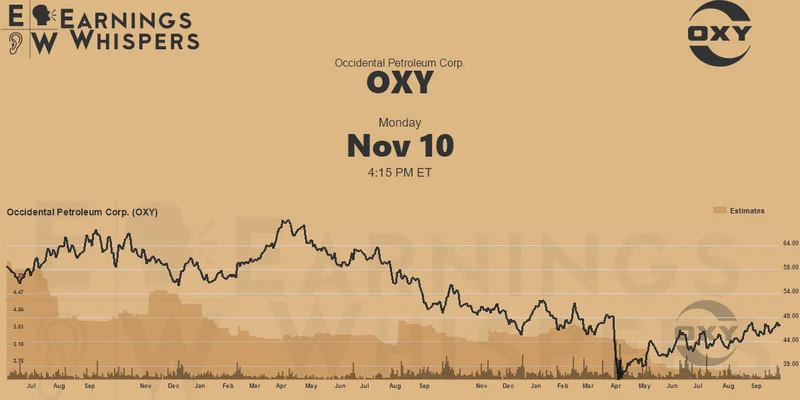The market has a fondness for simple signals. On Wednesday, October 1st, traders following Occidental Petroleum were given one of the simplest: a rumor of an acquisition, layered on top of a classic technical indicator. The result was predictable. Shares in OXY closed higher as chatter intensified that Berkshire Hathaway was preparing a $10 billion bid for its petrochemical division, OxyChem.
This price action was amplified by a chart pattern known as the “golden cross,” a textbook bullish signal where a stock’s 50-day moving average rises above its 200-day moving average. For a certain segment of the investment community, this confluence of events was an unambiguous directive to buy. The stock is now up more than 35%—to be more exact, a clean 35.4%—from its year-to-date low in April. The qualitative data from forums and social media shows a clear pattern: a spike in positive sentiment, with discussion volume correlating directly with the appearance of the golden cross and the Berkshire rumor. Retail investors, it seems, have received the signal and are acting on it.
And yet, a look beyond the retail-driven momentum reveals a significant discrepancy. The broader sentiment from Wall Street remains notably neutral, if not slightly pessimistic. This presents the central puzzle. We have a clear technical signal and a catalyst involving one of the world's most revered investors, yet the institutional money is not rushing in. The divergence in reaction suggests two very different interpretations of the same data. My analysis suggests the retail narrative is focused on the signal, while the institutional view is focused on the context.
A Survival Story Masquerading as Growth
A Critique of the Catalyst
Before we address the fundamentals, we must first examine the signal itself. A golden cross is, by definition, a lagging indicator. It confirms that bullish momentum has already been present for some time. Its predictive power is a subject of endless debate, and its reliability is highly variable. One need only look at OXY’s own recent history. The last time the stock formed a golden cross was in April 2024, an event that did not precede a sustained, long-term rally.
This is the part of the analysis where I find the retail reaction genuinely puzzling. An over-reliance on a single technical pattern, even one with a compelling name, is a methodological flaw. The current excitement seems to be a classic case of what I call catalyst-confirmation bias. The Berkshire rumor provides a powerful narrative, and the golden cross provides a seemingly objective, data-driven validation for that narrative. The two elements reinforce each other, creating a feedback loop that can briefly disconnect a stock’s price from its underlying financial reality.

But the rumor itself warrants skepticism. While details remain unconfirmed, the proposed $10 billion transaction for OxyChem is less a story of ambitious expansion and more a story of financial necessity. Occidental Petroleum, the Houston-based energy giant, is currently operating under the weight of a significant liability: a debt burden of approximately $24 billion. A $10 billion cash injection would not be used for aggressive growth or shareholder returns. It would be a crucial move to deleverage the balance sheet. This isn't a growth story; it's a survival story.
From this perspective, the tepid reaction from Wall Street becomes perfectly logical. An institution analyzing the transaction sees a heavily indebted company being forced to sell a productive asset. OxyChem is not a trivial division; it generated roughly $5 billion in revenue in the twelve months ending this past June. Selling it is a painful but necessary step to address a foundational weakness.
This brings us to the role of Berkshire Hathaway. The narrative that “Buffett is buying” is an oversimplification. Berkshire is not a new entrant here; it is a deeply entrenched existing shareholder. The firm already holds a stake of around 28% in Occidental (valued at nearly $13 billion). I've analyzed dozens of Berkshire's major investments, and this one has always been an outlier, born from a 2019 deal to help OXY finance its acquisition of Anadarko—the very deal that loaded up its balance sheet in the first place.
This potential $10 billion purchase of OxyChem would be Berkshire’s largest acquisition since its $11.6 billion deal for Alleghany, but the context is entirely different. This is not an opportunistic pounce on a new industry. It looks far more like a strategic move by a major creditor and shareholder to ensure the long-term stability of its initial, very large investment. Berkshire would be acquiring a cash-generating asset from a company it already partly owns, helping that company pay down debt and thereby protecting the value of its massive equity stake. It is a calculated, defensive maneuver, not the swashbuckling offensive charge that many seem to believe.
The signal being sent to the market is therefore complex and, for many, deeply misleading. Retail sees a golden cross and hears the name "Buffett." They see a buy signal. Institutional analysis looks at the same facts and sees a heavily leveraged company selling a core division to its largest shareholder to manage a debt crisis. They see a necessary, but hardly bullish, deleveraging event. The two realities are worlds apart.
The Debt Equation
The core of the matter is that you cannot analyze this transaction without seeing it through the lens of OXY’s $24 billion liability. The price action may be bullish today, but the underlying financial story is one of constraint. The market is reacting to a potential solution, but it seems to be forgetting the sheer scale of the problem. This deal, if it happens, doesn't magically transform Occidental into a high-growth powerhouse. It simply makes it a less fragile, heavily indebted company. That is the unvarnished truth of the numbers.
Reference article source:

